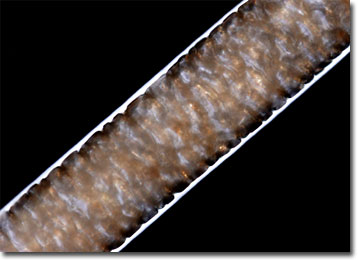Polarized Light Microscopy Digital Image Gallery
Guinea Pig Hair
Guinea pigs are not related to pigs, but to rodents, such as mice, rats, and hamsters. Their unusual common name is believed by some to have derived from the characteristic squealing noises they often produce.

View a second image of Guinea Pig Hair
The domesticated guinea pig is a cavy scientifically described as Cavia porcellus, which is native to South America. No longer found in the wild, the species is believed to have been domesticated thousands of years ago in pre-Incan Peru. Though common as pets in the United States, the small animals were originally raised as a readily sustainable food source and are still utilized as such in some locales. Relatively simple and inexpensive to rear, guinea pigs are perhaps more widely used, however, as research subjects in laboratories around the world.
The guinea pigs typically found in pet stores grow six to ten inches long and usually weigh two to four pounds. Their appearances may vary significantly, however, because breeders have developed many different types of domestic guinea pigs. Many of these breeds are primarily distinguished by their hair type. English and American breeds, for instance, have hair that is smooth and short, while the hair of Peruvian varieties is long and coarse. A wide array of hair colorations also exist among guinea pigs, and some breeds are even distinguished by rosettes, whorls of hair radiating from a center point, or the satiny sheen of their coat.
